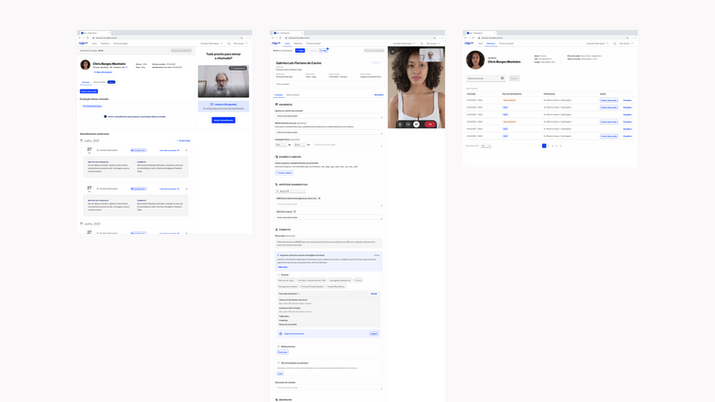Case Study
BR - SP
2009 - 2025
NavPro - Online medical care
www.dasa.com.br
Jan 2022/ Nov 2023
Type: Responsive platform
Comissioned by: Dasa S.A


Related metrics
-
TMO
-
Csat medics
-
Csat patients
-
Churn rate
Context
Platform for online healthcare, called NAV pro, Focused on solving the needs of doctors, where they could record diagnoses and prognoses, analyse medical history during real-time consultations with the patient as search and modify information after the consult.
Its main user is the team of registered doctors (around 20,000 people).
Challenge
-
Update resources according to technological improvements in the backend and IA technology
-
Ensure updated and correct information, as well as quick responses to searches carried out
-
Implementation of new micro services with the platform (Memed), resulting in the improvement of the service record
Team

Davi Januário
Product Designer

Sabrina Carmo
Project Manager

Karla Carvalho
Product Owner

Vanessa Jansen
Tech Leader
My responsabilities
Maintain relevant attributes that have already been configured for the product and work on concept projects (blue sea) to meet mapped needs.
Work effort
Some numbers to make the effort during my time in this squad tangible.
• 10 months (Jan 2023/ Nov 2023)
• 3 quarter
• 20 sprints
• 15 days each sprint
• Highly complex tasks
3 - 6
Initiatives
8 - 15
Epics
30 - 60
Stories
80 - 160
Tasks
Exemple
of outcome
High complexity
Example
of outcome
High complexity
Pain
There is no efficient data recording and information sanitization to ensure accurate searching and consistent feedback on suggestions and recommendations that the system can offer.
Job to Be Done
Search and view suggested tests based on medical history data already recorded during your online medical consultation.
Design process
BR - SP
2009 - 2024
Tools
Design
process
Duration
1 sprint (15 dias)
Tools



We analyzed the current workflow and identified key performance indicators:
-
65% of patient profiles had complete and up-to-date medical records.
-
3.5 seconds was the average time to retrieve patient history during consultations.
0.0/ 5
Average Time for Data Retrieval: Time taken to retrieve a patient’s medical history during a consultation
-
We saw an opportunity to improve real-time access to patient data. By creating a feature with seamless integration and processing, doctors can easily access patient histories and trust AI-powered test suggestions.
This builds confidence and improves the quality of care during appointments.We validated assumptions through qualitative research, usability tests and concept validation. We believe that:
-
Doctors are familiar with NAV Pro’s interface and use it regularly.
-
The system can handle real-time data processing and suggestions.
-
Doctors will adopt AI recommendations when data is complete and reliable.
-
Better data integration means better care and faster decision-making
-
We designed improvements aiming to:
-
Raise complete records from 65% to 90%.
-
Reduce data retrieval time from 3.5s to 1.2s.
We also addressed operational pain points by:
-
Adding automation tools for one-click actions.
-
Enabling batch processing to manage multiple schedules at once.
-
Improving integration with microservices to streamline workflows.
-
Reducing staff workload with task prioritization features.
-
Minimizing errors by adding smart checks in the process.
to 0.0/ 5
Average Time for Data Retrieval: Time taken to retrieve a patient’s medical history during a consultation
-




Impacts
Result of the all development done during the period I worked in the squad.
45%
TMO
70
Csat medics
Learning
Adapting to Technological Advances: Updating NAV Pro in line with the latest backend technologies and AI taught me the importance of staying ahead of industry trends. This experience highlighted how integrating advanced technologies can significantly enhance platform capabilities and user experience.
Data Accuracy and Efficiency: Ensuring that the platform provided up-to-date and correct information quickly was crucial. This project underscored the necessity of robust data management practices and efficient search algorithms, which are vital for maintaining the integrity and speed of information retrieval.
Microservices Integration: The integration of new microservices, like Memed, was a critical learning point. It demonstrated the value of modular architecture and how it can lead to significant improvements in service records and overall functionality.
User-Centered Design: By focusing on the needs of doctors, the project reinforced the importance of designing user-centric solutions that cater to specific professional requirements, ensuring that the platform enhances their workflow and productivity.

